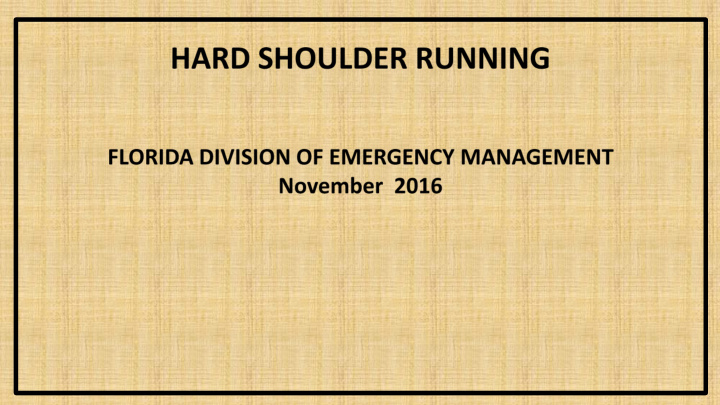



USE OF HARD SHOULDER RUNNING INSTEAD OF ONE-WAY OPERATIONS DURING HURRICANE EVACUATION o CONCEPT TO ALLOW VEHICLES TO USE OUTSIDE AND INSIDE SHOULDERS 5 LANES: 10 FT SHOULDER – 3 LANES @ 12 FT EACH – 10 FT SHOULDER I-4 EASTBOUND I-75 Exit 9 to SR-417 OSCEOLA COUNTY Exit 62 (53 Miles) I-75 NORTHBOUND TURNPIKE Exit 328 to I-10 Exit 435 (107 miles) o COORDINATION WITH VARIOUS STATE AGENCIES o FDOT o FHP o FDEM o FHWA
LIMITS OF HARD SHOULDER RUNNING
TYPICAL INTERSTATE SECTION
TYPICAL SHOULDER RUMBLE STRIP LOCATION
TYPICAL INTERSTATE SECTION
TYPICAL INTERSTATE PLAN
TYPICAL SIGN MESSAGES
WHEN TO USE: - Sufficient threat impacting at least one region - Category 4/5 Hurricane - Extreme vulnerability - Mandatory evacuation - Available time NOTE: - Road Rangers and FDOT Maintenance vehicles will be staged near interchanges to assist with disabled vehicles and incidents
PROS AND CONS OF HARD SHOULDER RUNNING PROS - 24/7 Operations - Less resources, especially for law enforcement o Law Enforcement Requirements (from 2014 plan) I-4: 151 I-75: 61 Does not include FDOT forces plus numerous traffic cones, barriers, signs, arrow boards - Can be implemented and shutdown on relatively short notice - Flexibility to implement in sections where there is congestion - Arterial and local roads are not disrupted - Does not impact responder flow as first responders can head towards area of impact - Provides additional options to One-Way Plans CON - Shoulders are not available for responders - Rumble strips - “Pinch Points” where full 10 foot shoulder not available - Shoulders need to be swept prior to use
CHALLENGES o “PINCH POINTS” Develop plan to address pinch points Active construction projects Identify pre-work Time to implement o PLANS DEVELOPMENT Signing plan and implementation o APPROVALS/CONSULTATION Executive Board FHP FHWA EOC
QUESTIONS/COMMENTS? THANK YOU!
Recommend
More recommend